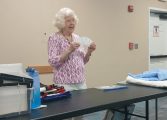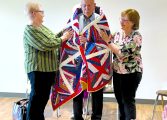Raised/Razed
Jordy Yager. Lorenzo Dickerson.
Submitted photo
On Nov. 23, at 3 p.m., Carysbrook Performing Arts Center will show the acclaimed documentary Raised/Razed. It focuses on Charlottesville’s oldest African American neighborhood Vinegar Hill. The documentary looks at the lives of residents as they faced racially discriminatory policies and a city government that saw them as the only obstacle to progress. The film discusses the harsh realities of the federal Urban Renewal Program and the history of its effect on other communities across America.
Writer and director of the film, Lorenzo Dickerson, and Jordy Yager, director of digital humanities at the Jefferson School African American Heritage Center, discussed their approach to creating this documentary. Yager said he and Dickerson saw it as a pattern of behavior that began with McKee Row in 1918 when the City of Charlottesville supported the razing of the Black neighborhood only to construct a park in honor of Confederate General Thomas “Stonewall” Jackson on the same land. In 1926, the city School Board seized Black-owned land and a home on 5th Street Northwest to build Jefferson High School, the city’s first and only Black high school. Twelve years later, in 1938, the city School Board seized the Black-owned land and homes along Pearl Street to build the all-white segregated Lane High School.
“By the 1950s and 1960s when the City began talking about razing the predominantly Black neighborhoods of Vinegar Hill, Cox’s Row, Garrett Street, and Gospel Hill, this pattern of actions had become praxis,” said Yager. “When we discuss the future of Black neighborhoods today, we need to keep this long history of forced displacement front and center in our minds. We saw the narrative of Vinegar Hill’s destruction becoming the central focus of how people referred to the neighborhood. With Raised/Razed we wanted to preserve the neighborhood as much as possible, to prevent a narrative erasure. Before it was destroyed, it was the center of life.”
Dickerson had a personal connection to Vinegar Hill.
“My great aunt and uncle owned the first Black-owned beauty supply store in Charlottesville, next door to the former Inges’ Store building. Growing up I heard stories of Vinegar Hill from my family members,” he said.
Dickerson’s research for the film came from various places including the Albemarle Charlottesville Historical Society and the original property assessments of Vinegar Hill that they had, including photos.
“When telling this story of a place that no longer exists, we were very conscious of doing what we could to piece together a visual representation of the neighborhood that viewers can understand and connect with. We accomplished this with a combination of before and after photography, mapping, and animation,” said Dickerson.
“When Jordy and I set out to make this film, being that we both are from the area, and had heard about Vinegar Hill from elders, and never learned about it in school, we wanted to focus on telling both sides of the story. The destruction, but also the life. Hence the title “Raised/Razed.” He adds that the film’s focus was to bring to light the first-hand experiences in Vinegar Hill, directly from the people who lived it. “We worked to capture the personal impact on the displaced residents beyond the nuts and bolts of the politics and details of the neighborhood’s destruction by having residents share their thoughts and feelings about what occurred and what it meant for their families.”
Vinegar Hill was about much more than just losing a physical place to live for its residents. Those social connections were lost as people moved to different locations. And generationally, families were no longer able to use their homes’ equity to accomplish things like sending children to college and starting businesses.
The most transformative part of the film for Jordy Yager was when George Ferguson, a former resident of Vinegar Hill, told an oral historian that if someone went down to the Charlottesville City Clerk’s Office and looked up who owned the properties in Vinegar Hill that the city called “slums” and “blighted” they would find that most of those properties were owned by White landlords who failed to keep their properties in good condition.
“Upon hearing this, Lorenzo and I went through the city property records and determined that Mr. Ferguson was entirely correct. Not only that, but we read through hundreds of pages of appraisal reports, and found that Black-owned homes in the neighborhood were some of the best-kept properties in the city, often cited as beautifully designed and constructed, and meticulously maintained,” he said. “This truth flew in the face of an often-told myth that Vinegar Hill’s Black properties were slums and blighted which Lorenzo and I had always known in our bones to be false, and now we had the undeniable proof.”
Their goal with the film was to have people learn about this history and the results that Urban Renewal that displaced more than 1.3 million people in more than 600 municipalities across the U.S.
“And while Charlottesville is no exception, this is our story and history. We also wanted people to understand that, for as much as our region has begun to talk about the history of Vinegar Hill, especially over the last 20 years, we have not begun to reckon with the impacts it had on the hundreds of Black residents and their descendants,” said Yager. “ In many ways, we are still struggling to listen to the voices of the families at the center of government policies—those who are most impacted, and who have the best situational expertise and insight as to how to improve our communities, are often most ignored.”
Yager added that with Raised/Razed “we intentionally wanted to take the concept of ‘progress,’ which was repeatedly cited by City officials and supporters of urban renewal, and challenge it. As Mark Bell so presciently puts it in the film: “Unfortunately, you can’t be surprised at what people will do in the name of progress—even though it’s not progress for a certain group of people.”
Dickerson and Yager agree that stories and narratives are the most powerful guiding forces we have as human beings.
“They are the vehicles we use to make our decisions and the tools we use to tell our history and impart lessons to the next generations,” said Yager.
For more information and tickets, visit www.carysbrook.org.




